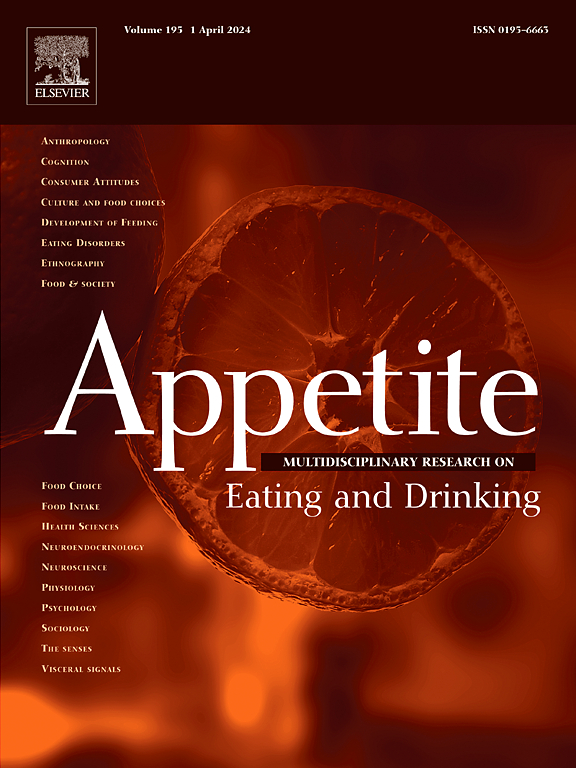自我报告的喜好和享乐性暴饮暴食的食物水平预测:把超加工食品放在背景下
IF 4.6
2区 医学
Q1 BEHAVIORAL SCIENCES
引用次数: 0
摘要
人们赋予食物的奖励价值是由食物的内在属性(食物水平)决定的,并受到个体因素(如特征、状态和信仰)的调节。有必要对食物层面的特征进行更系统、更结构化的分析,以解释对食物奖励的认知,如适口性和奖励驱动的暴饮暴食的风险。本研究包括三项研究,旨在探讨食物的营养,感官和认知特征和属性作为食物奖励相关结果的决定因素。在三个连续的在线研究设计中,来自普通人群的1176名男性和2188名女性对436种食物的子样本进行了评分,这些食物从数据库中取样,并拍照,以代表英国的即食食品和饮料产品。研究结果是自我报告的食物喜好和享乐性暴饮暴食,而预测因素是食物的营养成分,包括超加工食品状态(upf)和碳水化合物与脂肪比(CFR);以及参与者自我报告的关于食物的营养和感官特征的信念。相关和逐步回归分析用于模拟重要的营养成分,然后使用层次回归模型来检查自我报告的食物水平属性,或CFR和upf作为潜在的附加模型。在所有研究中,食物的营养特性解释了喜欢程度差异的20%和享乐性暴饮暴食差异的40 - 60%。自我报告的食物水平属性进一步解释了6 - 33%的喜好差异和17 - 38%的享乐性暴饮暴食差异。upf解释了0 - 7%的额外方差,而CFR没有添加到营养模型中。这项研究证明了食物的营养特性如何影响自我报告的喜好和享乐性暴饮暴食。考虑到人们对营养和感官属性的看法,可以解释的不仅仅是营养,CFR或upf对食物奖励的附加贡献可以忽略不计。本文章由计算机程序翻译,如有差异,请以英文原文为准。

Food-level predictors of self-reported liking and hedonic overeating: Putting ultra-processed foods in context
The reward value people assign to foods is determined by their intrinsic (food-level) properties and moderated by individual factors such as traits, states and beliefs. There is a need for more systematic, structured analyses of the food-level characteristics that explain cognitions about food reward such as palatability and their risk for reward-driven overeating. This research, consisting of three studies, aimed to explore the nutritional, sensory and cognitive characteristics and attributes of foods as determinants of food reward-related outcomes. Across three sequential online study designs, 1176 men and 2188 women from the general population rated sub-samples of 436 foods which were sampled from databases and photographed to represent ready-to-eat food and beverage products in the UK. The study outcomes were self-reported food liking and hedonic overeating, while the predictors were the nutritional composition of the foods including ultra-processed food status (UPFs) and carbohydrate-to-fat ratio (CFR); and participants' self-reported beliefs about the nutritional and sensory characteristics of the foods. Correlation and stepwise regression analyses were used to model significant nutritional components followed by hierarchical regression models to examine self-reported food-level attributes, or CFR and UPFs as potential additive models. Across all studies, the nutritional characteristics of foods explained ∼20 % variance in liking and 40–60 % variance in hedonic overeating. Self-reported food-level attributes explained a further 6–33 % variance in liking and 17–38 % variance in hedonic overeating. UPFs explained 0–7 % additional variance and CFR did not add to the nutritional models. This research demonstrates how nutritional characteristics of foods contribute to self-reported liking and hedonic overeating. Considering people's beliefs about nutrient and sensory attributes can explain more than nutrients alone, and there are negligible additive contributions from CFR or UPFs on food reward.
求助全文
通过发布文献求助,成功后即可免费获取论文全文。
去求助
来源期刊

Appetite
医学-行为科学
CiteScore
9.10
自引率
11.10%
发文量
566
审稿时长
13.4 weeks
期刊介绍:
Appetite is an international research journal specializing in cultural, social, psychological, sensory and physiological influences on the selection and intake of foods and drinks. It covers normal and disordered eating and drinking and welcomes studies of both human and non-human animal behaviour toward food. Appetite publishes research reports, reviews and commentaries. Thematic special issues appear regularly. From time to time the journal carries abstracts from professional meetings. Submissions to Appetite are expected to be based primarily on observations directly related to the selection and intake of foods and drinks; papers that are primarily focused on topics such as nutrition or obesity will not be considered unless they specifically make a novel scientific contribution to the understanding of appetite in line with the journal's aims and scope.
 求助内容:
求助内容: 应助结果提醒方式:
应助结果提醒方式:


